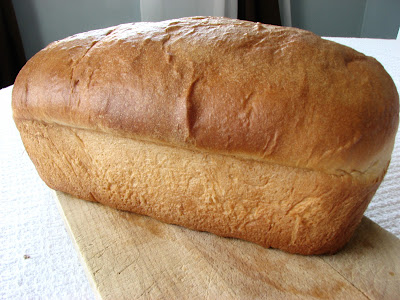I love making homemade bread! Working with yeast is magical, watching the changes in the dough as it is worked is fascinating to me. Over the past several years I have made quite a few loaves of bread, and I can tell that I improve with each loaf. It definitely takes practice.
Although I love good, crusty loaves and rustic, chewy rolls, hearty breads that give your jaw a workout, there are times when I want something different. There are times when I want (dare I say it?) white wonder bread. I'm sorry, but you cannot have a good peanut butter sandwich on two thick, hearty, dense slices of bread. It just does not work, it's way too dry. Peanut butter sandwiches require the softest, fluffiest, moistest slices of bread you can find, and up until now I could not make this bread. Every recipe I tried for white sandwich bread was delicious, but not soft enough for my peanut butter. Then I found this recipe.
I love browsing recipes on King Arthur Flour's web site. They have so many delicious looking recipes, along with lots of hints and tips. I had been wanting to make this recipe for a while, but it has a few ingredients that I don't normally have on hand, mainly instant mashed potato flakes and dry milk powder. Neither ingredient is difficult to find or expensive, but I never got around to buying them. Boy am I glad I finally did. This bread turned out so delicious, soft and fluffy, rich and moist, the perfect peanut butter sandwich bread!
Try this recipe. It will change your sandwich life. I want to make it every week, and eat sandwiches for every meal. So go out and by the dry milk powder and instant mashed potato flakes, trust me, you won't regret it.
My beautiful loaf, sunbathing
Second rise time
Ready to bake
Yum! I want to eat it NOW
Out of the pan, ready to cut
From King Arthur Flour
Ingredients
- 2 1/2 teaspoons instant yeast
- 7/8 to 1 1/8 cups lukewarm water (7 to 9 oz)*
- 3 cups all purpose flour (12 3/4 oz)
- 1 1/4 teaspoons salt
- 3 tablespoons sugar
- 6 tablespoons unsalted butter, room temperature (3 oz)
- 1/4 cup nonfat dry milk (5/8 oz)
- 1/2 cup instant mashed potato flakes (1 1/2 oz)
Directions
If you're using active dry yeast, dissolve it with a pinch of sugar in 2 tablespoons of the lukewarm water. Let the yeast and water sit at room temperature for 15 minutes, until the mixture has bubbled and expanded. If you're using instant yeast, you can skip this ste
Combine the dissolved yeast (or instant yeast) with the remainder of the ingredients. Mix and knead everything together—by hand, mixer or bread machine set on the dough cycle—till you've made a smooth dough. If you're kneading in a stand mixer, it should take about 7 minutes at second speed, and the dough should barely clean the sides of the bowl, perhaps sticking a bit at the bottom. In a bread machine (or by hand), it should form a smooth ball.
Place the dough in a lightly greased bowl. Cover the bowl, and allow the dough to rise, at room temperature, for 1 to 2 hours, or until it's nearly doubled in bulk. Rising may take longer, especially if you've kneaded by hand. Give it enough time to become quite puffy
Gently deflate the dough, and shape it into an 8" log.
Transfer the log, smooth side up, to a lightly greased 8 1/2" x 4 1/2" loaf pan. Tent the pan loosely with lightly greased plastic wrap.
Allow the bread to rise till it's crested about 1 1/4" over the rim of the pan, about 1 hour. Again, it may rise more slowly for you; let it rise till it's 1 1/4" over the rim of the pan, even if that takes longer than an hour. While the dough is rising, preheat the oven to 350°F.
Bake the bread for 15 minutes. Tent it lightly with aluminum foil, and bake for an additional 20 to 25 minutes, till the crust is golden brown, and the interior temperature measures 190°F on an instant-read thermometer.
Remove the bread from the oven, and gently loosen the edges with a heatproof spatula or table knife. Turn it out of the pan, and brush the top surface with butter, if desired; this will give it a soft, satiny crust. Allow the bread to cool completely before slicing. As soon as it's completely cool, wrap it tightly in plastic wrap; or in a plastic bag, air pressed and fastened securely at the top.













Yum Yum Yum!!! Anyone reading this blog should go out and make this right now! It is so worth it!
ReplyDeleteI made this bread and I've always had trouble with bread that I made this recipe and that is the best bread I have ever eaten in my entire life so thank you for posting.
ReplyDelete